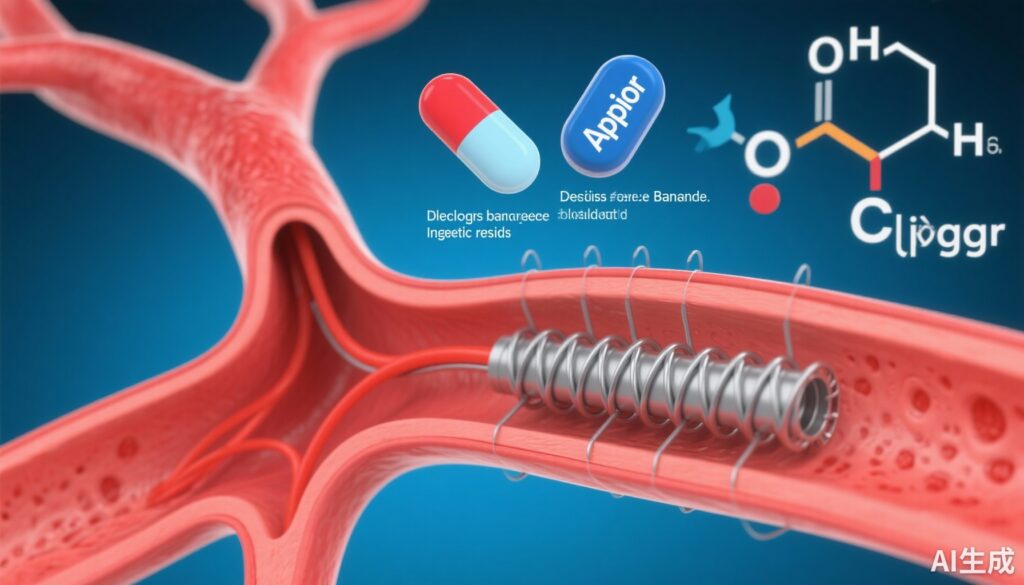Highlight
Key points from the STOPDAPT-3 trial include: 1) Aspirin and clopidogrel monotherapy beyond the first month post-PCI offer similar protection against major cardiovascular events in ACS patients. 2) High bleeding risk or acute coronary syndrome subtype (STEMI vs. NSTE-ACS) do not significantly alter the relative efficacy or safety between these two antiplatelet agents. 3) Major bleeding outcomes were comparable, supporting flexible antiplatelet strategies depending on patient profiles. 4) These findings may influence tailored antithrombotic approaches beyond the acute phase of ACS management.
Study Background and Disease Burden
Acute coronary syndrome (ACS), encompassing ST-segment elevation myocardial infarction (STEMI) and non-ST-segment elevation ACS (NSTE-ACS), remains a leading cause of morbidity and mortality worldwide. Following percutaneous coronary intervention (PCI), dual antiplatelet therapy (DAPT) is standard to reduce ischemic events such as stent thrombosis and recurrent myocardial infarction. However, prolonged antiplatelet therapy increases bleeding risks, which can worsen outcomes, especially in patients classified as high bleeding risk (HBR). Optimal duration and choice of antiplatelet agents to balance ischemic protection with bleeding hazard are under extensive investigation. Aspirin, historically the cornerstone, is increasingly challenged by P2Y12 inhibitors such as clopidogrel for monotherapy following the initial DAPT period, but data remain limited in ACS subgroups distinguished by bleeding risk and STEMI presentation. Understanding how aspirin compares to clopidogrel in these specific contexts addresses a critical gap in personalized post-PCI care.
Study Design
The Short and Optimal Duration of Dual Antiplatelet Therapy-3 (STOPDAPT-3) trial was a prospective study enrolling 4,353 patients presenting with ACS who underwent PCI. Patients were followed for a duration up to one year after transition to monotherapy beyond 30 days post-PCI. Participants were stratified into prespecified subgroups based on bleeding risk profile—high bleeding risk (HBR) versus non-HBR—and ACS subtype, STEMI or NSTE-ACS. The study compared aspirin monotherapy versus clopidogrel monotherapy with respect to cardiovascular and bleeding outcomes.
The co-primary cardiovascular endpoint was a composite of cardiovascular death, myocardial infarction, definite stent thrombosis, or ischemic stroke. The co-primary safety endpoint was major bleeding defined by Bleeding Academic Research Consortium (BARC) type 3 or 5 criteria.
Key Findings
Of the enrolled cohort, 1,711 were classified as HBR and 2,457 presented with STEMI. Over a median follow-up of 335 days, hazard ratios (HRs) for aspirin compared to clopidogrel demonstrated no statistically significant differences in cardiovascular outcomes, regardless of bleeding risk or ACS subtype:
- HBR subgroup: HR 0.89 (95% CI 0.61-1.30)
- Non-HBR subgroup: HR 1.08 (95% CI 0.61-1.90)
- STEMI subgroup: HR 1.01 (95% CI 0.68-1.50)
- NSTE-ACS subgroup: HR 0.81 (95% CI 0.48-1.37)
The interaction p-values indicated no significant heterogeneity by subgroup (P for interaction ≥0.51).
Similarly, major bleeding events did not significantly differ between aspirin and clopidogrel arms across subgroups:
- HBR: HR 0.73 (95% CI 0.40-1.33)
- Non-HBR: HR 0.71 (95% CI 0.23-2.24)
- STEMI: HR 0.96 (95% CI 0.46-2.01)
- NSTE-ACS: HR 0.53 (95% CI 0.24-1.17)
These results suggest comparable safety profiles between agents beyond 30 days post-PCI.
Secondary analyses assessing individual components of the cardiovascular endpoint and bleeding types similarly showed no clear benefit favoring one agent over the other. Overall, the data support clinical equipoise and suggest that either aspirin or clopidogrel monotherapy may be reasonable following the initial DAPT period in ACS patients regardless of bleeding risk or ACS subtype.
Expert Commentary
The STOPDAPT-3 trial adds important nuance to antithrombotic management in ACS patients undergoing PCI. Previous studies have demonstrated the efficacy of P2Y12 inhibitor monotherapy after abbreviated DAPT, but many lacked power for subgroup analyses by bleeding risk or STEMI status. This trial’s findings mitigate concerns that aspirin or clopidogrel monotherapy may differentially impact clinical outcomes in high-risk patients or STEMI cohorts.
From a mechanistic perspective, aspirin irreversibly inhibits cyclooxygenase-1, reducing thromboxane A2 mediated platelet aggregation, while clopidogrel blocks P2Y12 receptor-mediated platelet activation. Both pathways are central to thrombosis, yet their relative influence may vary with clinical context. The comparable outcomes contest the superiority of either pathway blockade alone in these subgroups during the maintenance phase post-PCI.
Nonetheless, it is important to acknowledge limitations including the open-label design, exclusion of newer P2Y12 inhibitors such as ticagrelor, and applicability primarily to an East Asian population, which might affect generalizability to other ethnic groups given observed differences in bleeding and ischemic risk. Furthermore, adherence and dosing nuances were not exhaustively captured. Future trials with broader ethnic representation and incorporation of contemporary P2Y12 inhibitors are warranted.
Current guidelines increasingly endorse individualized DAPT durations based on ischemic and bleeding risk balancing. STOPDAPT-3’s results align with this direction, offering evidence that aspirin or clopidogrel monotherapy choice may be safely personalized without compromising efficacy or increasing bleeding beyond the first month.
Conclusion
In patients with ACS undergoing PCI, aspirin and clopidogrel monotherapy beyond one month and until one year post-procedure demonstrated comparable efficacy in preventing major cardiovascular events and similar major bleeding risks. These results were consistent irrespective of patients’ high bleeding risk status or STEMI versus NSTE-ACS presentation. These findings support a flexible approach to monotherapy selection that can be tailored to individual patient characteristics and preferences, potentially simplifying and optimizing long-term antiplatelet management strategies in ACS survivors.
Further large-scale, diverse population studies are needed to confirm these findings and examine newer P2Y12 inhibitors in this clinical context.
References
Obayashi Y, Natsuaki M, Watanabe H, Morimoto T, Yamamoto K, Nishikawa R, Kimura T, Ando K, Suwa S, Isawa T, Takenaka H, Ishikawa T, Tokuyama H, Sakamoto H, Fujita T, Nanasato M, Okayama H, Nishikura T, Kirigaya H, Nishida K, Ono K, Kimura T; STOPDAPT-3 Investigators. Aspirin vs Clopidogrel 1 Month After Acute Coronary Syndrome With High-Bleeding Risk or ST-Segment Elevation. JACC Cardiovasc Interv. 2025 Sep 8;18(17):2120-2135. doi: 10.1016/j.jcin.2025.03.029. Epub 2025 Jun 4. PMID: 40471776.
Collet JP, Thiele H, Barbato E, et al. 2020 ESC Guidelines for the management of acute coronary syndromes in patients presenting without persistent ST-segment elevation. Eur Heart J. 2021;42(14):1289-1367. doi:10.1093/eurheartj/ehaa575
Valgimigli M, Bueno H, Byrne RA, et al. 2017 ESC focused update on dual antiplatelet therapy in coronary artery disease developed in collaboration with EACTS. Eur Heart J. 2018;39(3):213-260. doi: 10.1093/eurheartj/ehx419



